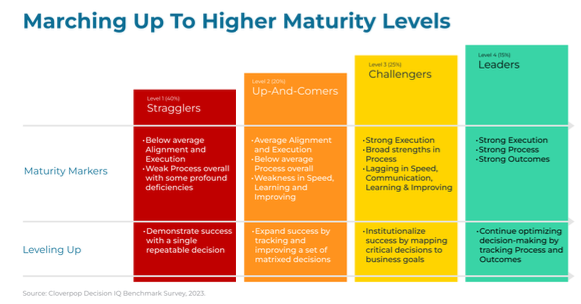Decision IQ Study Finds Only 15 Percent Of Companies Are Decision Leaders – Here’s How The Rest Can Catch Up
Erik Larson
Mar 27, 2023 7:30:00 AM


Our recent Decision IQ research found that fewer that one in six companies have a powerful combination of consistently strong decision-making processes, excellent execution and outstanding decision outcomes. So how can other companies catch up?
As the new research white paper details, the answer to that question depends on each company’s decision-making maturity level. Disclosure: I researched this while co-founder and Chief Product Officer of the Cloverpop decision intelligence platform.
The research buckets companies into four Decision IQ maturity levels:
Just like learning a new sport, companies at each level of maturity must focus on the right skills for their current capabilities. Beginner skiers start on bunny slopes, not black diamonds, while advanced skiers never become experts if they don’t push themselves on ever more challenging runs.
Taking a decision-back approach is a powerful tool for increasing a company’s Decision IQ. Working decision-back involves creating a map of critical decisions required to achieve business goals and aligning employees around efficient decision-making processes supported by relevant data and insights. This is done in four steps:
This approach puts predictable, fast, high-quality decision processes in place by working back from business goals to the decisions that drive those goals and then to the people and analysis required for those decisions.
However, while this comprehensive decision-back strategy is a good target for leading companies, the reality is that most are not ready for such an advanced approach. Companies at lower Decision IQ maturity levels require phased strategies to level up.

Stragglers face a potentially overwhelming array of decision challenges with relatively few examples of excellence to hold up as models. Thus, a tight focus is best to demonstrate success and then scale from there.
There are no shortcuts to rising above the difficulties that Stragglers face. Instead, it requires a disciplined effort to demonstrate and replicate success decision-by-decision.
Up-And-Comer companies have scattered examples of successful decision-making that set the stage for significant improvement if they can tie those examples together across more complex decision-driven processes.
It’s important to note that while decision Speed stands out as a widely felt and urgent problem facing Up-And-Comers, simply urging people to go faster rarely works. Instead, the famous Navy SEAL adage that “slow is smooth and smooth is fast” holds. Doing the slow work up front to structure and track key decision-driven processes unlocks the improvements required to achieve next-level speed.
Challengers are on the cusp of true decision excellence. They already have many robust decision processes but lack the learning and improving processes required to institutionalize consistently successful decision outcomes. Becoming a Leader requires building a learning organization that drives the Decision IQ flywheel over time.
What gets measured gets managed. Challengers can use that business mantra to nudge their companies’ Decision IQ into the Leader category by measuring key decision results and decision-making process metrics one business goal at a time.
This article was originally published in Forbes.